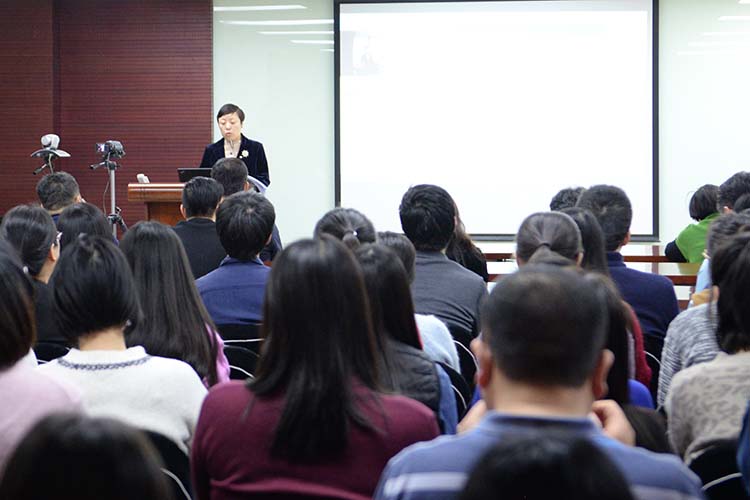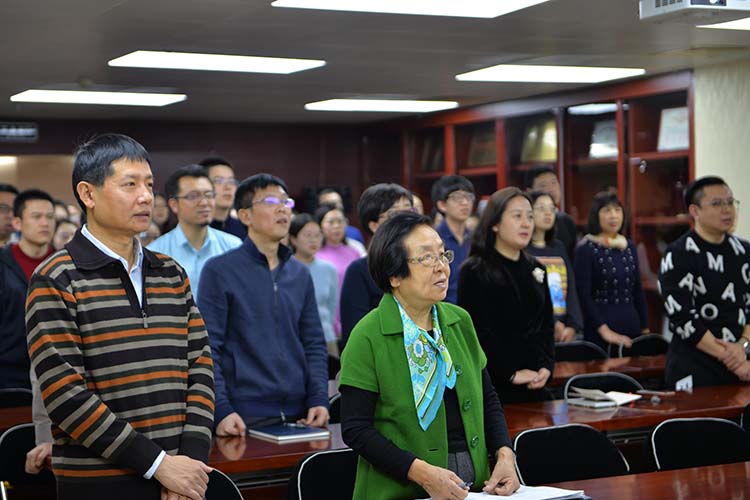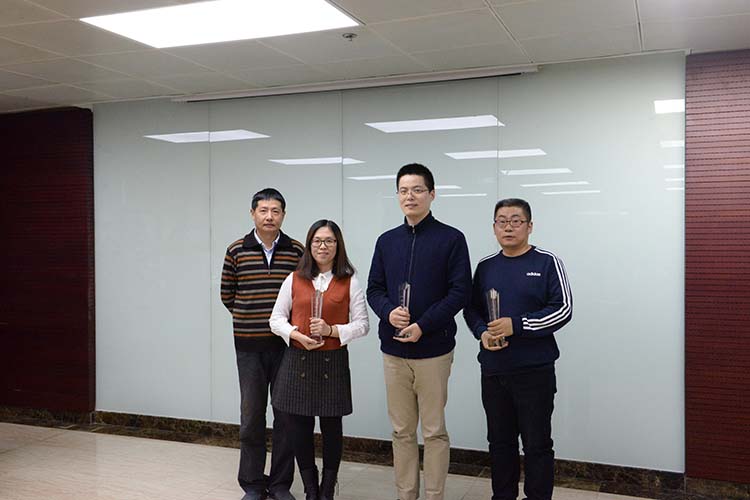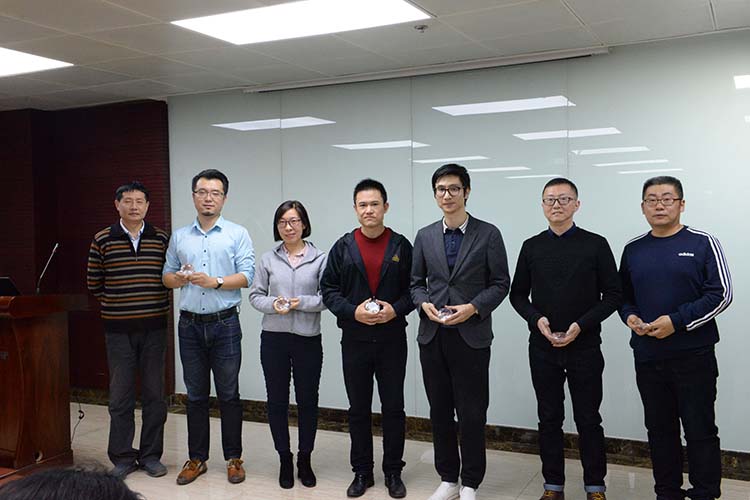The number of trademark registrations was 5.007 million, of which 4.797 million were domestic trademarks.The number of applications for international registration of Madrid trademarks was 6,594. In 2018, a total of 8.043 million trademark registration applications were concluded, and the average review period for trademark registration was shortened to less than 6 months. The time for the trial of the trademark refusal review case is reduced to less than 7 months.In this year, 67 geographical indication products were approved for protection, 961 geographical indication trademarks were registered, and 223 enterprises were authorized to use geographical indication product special signs.In 2018, the CNIPA received a total of 4,431 applications for layout design registration of integrated circuits, an increase of 37.3% over the same period of last year; 3,815 integrated circuit layout designs were issued, an increase of 42.9% over the same period of last year. In 2018, the total number of patent administrative law enforcement cases in the country was 77,000, a year-on-year increase of 15.9%.The authority investigated and dealt with 43,000 counterfeit patent cases, an increase of 10.9%.The authority investigated and dealt with 31,000 trademark violation cases, with a case value of 550 million yuan. The first case of infringement dispute over the layout of integrated circuits was also handled. In 2018, the total import and export of intellectual property fees exceeded USD 35 billion. The total amount of patent and trademark pledge financing reached 122.4 billion yuan, a year-on-year increase of 12.3%.
(Source: CNIPA Network)
Smart trademark graphic retrieval function officially launched
On January 25, the smart trademark graphic retrieval function was officially launched. This is a new milestone in building trademark informatization following the full online launch of the trademark online service system and the free opening of the trademark database to the society, marking a new starting point for the transformation of China’s trademark review from automation to intelligence. The application of intelligent retrieval technology has realized the transformation of the trademark review work from pure manual retrieval to “search graph with graph” intelligent retrieval, effectively avoiding the problem of inconsistent standards caused by individual judgments.The number of similar trademarks needing to be compared was halved from around ten thousand to around five thousand. In the next step, the Trademark Office will continue to promote the deep integration of AI technology and trademark review, expand the application scope of new technologies such as AI in the trademark field, strengthen the building of information technology, further enhance the quality and efficiency of trademark review, and continuously improve the service level of trademarks.
(Source: China Intellectual Property Network)
The PCT Collaborative Search and Examination (CSE) pilot will be restarted on March 1, 2019
The PCT Collaborative Search and Examination Pilot (CSE) of the China, the United States, Europe, Japan and Korea Intellectual Property Offices was launched on July 1, 2018.For a period of two years, the number of pilot cases accepted by each Office is 100, the quota for each pilot year is about 50, and English PCT applications have priority in the pilot program.After the pilot was launched, the reaction was good and the number of pilot cases exceeded 40 in November 2018.In order to ensure the effect, the CNIPA issued a notice on November 7 last year to suspend the CSE request until PCT application in Chinese language are accepted. At present, the CNIPA has completed the preparation for PCT application in Chinese to participate in the pilot program, and decided to begin accepting such applications from March 1, 2019.The follow-up arrangements are as follows: 1. From March 1st to June 30th, 2019, applicants may file PCT applications in Chinese to CNIPA according to “PCT Collaborative Search and Examination Pilot (PCT CSE)Pilot Project User Guide (Chinese PCT Application Edition)”. During this period, the English PCT application will not be accepted; the acceptance limit is 10 pieces, and each applicant is limited to 2 pieces. 2. The applicant is required to submit an English translation of the Chinese PCT application at the time of filing the Chinese PCT application or within one month, and to ensure the quality of the translation. Subject to the quota of this pilot, those who submit an English translation meeting the quality requirements earlier will be given priority to participate in the pilot program. 3. From July 1, 2019 to June 30, 2020, CNIPA will accept both Chinese and English PCT applications for participation in the pilot program. 4. If the number of pilot cases reaches the limit, the CNIPA will issue a notice to suspend or stop accepting relevant requests.
(Source: China Intellectual Property Network)
“Measures for Rapid Handling of Patent Infringement Disputes in Small and Medium-sized Enterprises in Beijing (Trial)” published
Recently, the Beijing Intellectual Property Office issued “Measures for Rapid Handling of Patent Infringement Disputes in Small and Medium-sized Enterprises in Beijing (Trial)” (hereinafter referred to as “Measures”). The implementation of the Measures will significantly shorten the processing cycle of eligible patent infringement disputes for small and medium-sized enterprises in Beijing. The Measures include 18 Articles, regulating the application scope, the conditions of acceptance, the time limit for examination and the handling process of infringement disputes of small and medium-sized enterprises. The Measures have strengthened the protection of intellectual property rights for small and medium-sized enterprises, effectively promoted small and medium-sized enterprises to accelerate technological innovation, and provided important guarantees for building a good business environment in the capital.
(Source: CNIPA Network)
The examination quality and efficiency of the CNIPA Patent Reexamination Board is further improved
In 2018, the number of accepted patent reexamination cases was about 37,800, an increase of 11% over 2017; the number of accepted patent invalidation cases was approximately 5,235, an increase of 15% over 2017; the number of accepted patent reexamination and invalidation litigation cases was about 2,149, an increase of 21.4% over 2017. The number of closed reexamination cases was 28,400, the number of closed invalidation cases was 4,217, the number of closed litigation cases was 1,548, and the rate of loss was 11.7%. In 2018, the reexamination cases were averagely concluded by 11.1 months, and the invalidation cases were averagely concluded by 5.1 months. There were 57 reexamination cases closed with the priority examination procedure, with an average period of 6.7 months; 88 invalidation requests were closed with the priority examination procedure, with an average period of 4.4 months.
(Source: China Intellectual Property News)
2018 National Science and Technology Awards List released
The Central Committee of the Communist Party of China and the State Council held a National Science and Technology Awards Conference in Beijing on the morning of January 8. The 2018 National Science and Technology Awards selected 278 projects and 7 scientific and technical experts. Among them, there were 38 national natural science awards, including 1 first prize and 37 second prizes; 67 national technical invention awards, including 4 first prizes and 63 second prizes; 173 national science and technology progress awards, including 2 special prizes, 23 first prizes and 148 second prizes; awarded 5 foreign experts to the People’s Republic of China International Science and Technology Cooperation Award; 2 national highest science and technology awards: academician Liu Yongtan of Harbin Institute of Technology, and academician Qian Qihu of the Chinese People’s Liberation Army Engineering University.
(Source: Xinhuanet)
Ministry of Industry and Information Technology: China’s 5G international patents have exceeded 2,400
Huawei and ZTE have more than 2,400 patents in the 5G international standard, accounting for more than 30%. Recently, the Ministry of Industry and Information Technology revealed that China has already led the completion of 49 international telecommunication alliance standards and initiated 73 new projects, which has effectively promoted China’s standards to become international standards. On the same day, the Ministry of Industry and Information Technology released a list of “100 Group Standard Application Demonstration Projects” covering key areas such as communications, robotics, and green manufacturing. According to reports, in 2018, China’s industrial communications industry aimed at internationalization and going abroad, approved more than 1,800 industry standards, and issued guidelines for the construction of standards systems in key areas such as smart manufacturing and car networking. Up to now, the Ministry of Industry and Information Technology has released more than 200 group standard application demonstration projects.The Content and Method of Road Test Capability Assessment for Auto-driving Vehicles has also become one of the “100 Group Standard Application Demonstration Projects”. According to reports, at present, 8 companies have obtained road test qualifications for self-driving vehicles in Beijing, and 3 have been qualified for road tests in Shenzhen, Wuxi and Tianjin. Among them, the mileage of self-driving road test in Beijing alone has reached about 130,000 kilometers, which has created a good practice environment for industrial development.
(Source: China Industrial Economic Information Network)
Dragon Special Report and Agency Practice
Dragon Group convened the 2018 Year-end conference and commendation conference
On January 30, 2019, Dragon Group held its 2018 year-end conference and commendation conference at its Beijing headquarters. Chairperson Hao Qingfen, Chairman Hao Xinghua, CEO Xu Jing, all members of the management committees, outstanding employees and representatives of outstanding departments attended the meeting.The employees of the branch and subsidiaries watched the conference simultaneously through the live webcast.
The conference began in the “Song of Dragon IP”.
Ms. Xu Jing delivered an exciting annual report that Dragon IP handled 13,688 cases in 2018, 5% over the plan and 1,482 more than the number in 2017. Such success is possible because of the stable growth in patent and trademark business, development of new markets and clients, and novel services available to clients. Besides, 2018 also witnessed Dragon IP 20th anniversary celebration and implementation of D system first phase plan-two major events for Dragon IP. The 20th anniversary celebration is a conclusion of past glory, and the D system paves the way for future success. Ms. Xu Jing also pointed out the work goals of 2019, announced new appointments and departmental adjustments, and introduced the new management model of the Dragon IP Business Departments.
At the meeting, Chairman Hao Xinghua read out the list of outstanding employees and outstanding departments in 2018, and presented awards to these employees and departments.Mr. Hao expressed his expectation of more achievements from these people and departments and his hope that others will learn from them.
At the turn of this year, Dragon IP renews its goal to provide best services to the clients, make contribution to the community and add a wood to the fire of IP industry.




Analysis of strategy for drafting patent applications involving business methods
I.Introduction
With the development of Internet+, people are enjoying more benefits from the Internet. Innovative business models have overturned people’s lifestyles, and companies will compete more fiercely in the field of business method.
Patent is given more importance as a way to protect business methods, but in practice, patents involving business methods are usually rejected on the basis that they do not belong to patentable subject matters. It is a pity that such applications are rejected due to non-combination with technical contents and inappropriate drafting. This article intends to provide some strategies for drafting patent applications involving business methods based on relevant examination standards and real cases.
II.Analysis of examination standards for patent applications involving business methods
Examination standards for patent applications involving business methods are stipulated by Article 2 of the Patent Law, provisions about unpatentable subject matters in Article 25 of the Patent Law, and provisions about novelty, inventiveness and practical applicability in Article 22 of the Patent Law.
Article 2 of the Patent Law stipulates patentable objects: “Invention” means any new technical solution relating to a product, a process or improvement thereof.
A technical solution is a collection of technical means that utilizes the laws of nature to solve a technical problem. Technical means are usually embodied by technical features. A solution that does not use technical means to solve technical problems and obtain technical effects in accordance with natural laws is not an object specified in Article 2.2 of the Patent Law.
Article 25.2 of the Patent Law stipulates unpatentable subject matters: no patent right shall be granted to rules and methods for mental activities.
Rules and methods for mental activities refer to the rules and methods that guide people to think, express, judge, and remember. Since they do not use technical means, solve technical problems or produce technical effects, rules and methods for mental activities do not constitute a technical solution. Because rules and methods for mental activities do not conform to Article 2.2 of the Patent Law and belong to unpatentable subject matters stipulated by Article 25.1.2 of the Patent Law, rules and methods guiding people in conducting such activities are not granted patents.
In practice, patent applications involving business methods are divided into two categories based on their contents:
(1) Claims concerning only rules and methods for mental activities, i.e., patent application for pure rules and methods for mental activities.
(2) Claims in its whole contents containing not only matter of rule or method for mental activities but also technical features, i.e., patent application relating to rules and methods for mental activities.
According to the Guidelines for Patent Examination, the examination standard for applications belonging to case (1) is: If a claim concerns only rules and methods for mental activities, it shall not be granted a patent right. It belongs to unpatentable subject matters prescribed by Article 25 of the PRC Patent Law.
According to the Guidelines for Patent Examination, the examination standard for applications belonging to case (2) is: If a claim in its whole contents contains not only matter of rule or method for mental activities but also technical features, then the claim, viewed as a whole, is not a rule or method for mental activities, and shall not be excluded from patentability under Article 25.
Most actually-filed patent applications belong to case (2), but examiners usually reject them without search on the basis that they are not technical solutions stipulated by Article 2.2 of the Patent Law.
A patent application involving a business model (or method) refers to an invention patent application on the subject of implementing a business method using computer and network technology. Such applications mainly belong to classifications of G06Q, G06F, G07G, G07D, G07F, H04L, H04W;and H04M. More specifically, such applications concentrate at G06Q 30/00 (commercial, such as shopping or e-commerce finance) and G06Q 40/00 (financial; insurance; tax strategy; treatment of company or income tax).
According to statistics, such invention applications have a low allowance rate. They are rejected mostly because they do not belong to objects subject to protection by Article 2 and secondly because they lack inventiveness.
A typical rejection ground is like this: The technical content involved is a prior art, the solution of the claim is to solve the commercial problem by using the technical content of the prior art, the problem to be solved is not a technical problem, and the effect brought about is not a technical effect. Therefore, the solution of the claim does not belong to Article 2.2 of the Patent Law.
Attorneys and applicants often find it hard to respond such rejection. In other words, they can hardly prove that the technical contents in the claims are not prior art, a technical problem instead of a business problem is solved, and the effect is a technical effect.
The author believes that, if technical means are used to solve a business problem in the claims of a patent application involving a business model (or method), the solution in its whole contents solves a technical problem and produces technical effect. If the technical content belongs to prior art or conventional technical means or can be easily conceived by a person having ordinary skill in the art, the application may be rejected for lacking inventiveness but not for not being a technical solution.
An example is provided below.
A method for implementing electronic transaction based on interactive network television, characterized in that it comprises the following steps:
he settop box on the user side accessing the server in the display hall on the network side, and displaying the product information to the user;
after the user selects the ordered item, the set top box sending a request message for ordering the item to the server;
the server sending the information of the user’s ordered itemto the service server;
the business server generatingan order based on the product information ordered by the user.
Rejection ground: The solution utilizes the interaction between the set top box and the server to realize the user’s purchase of goods. The problem actually solved is a business operation mode, which is not a technical problem. Although the technical solution utilizes the information interaction between the set top box and the server, they are all known devices or means. The action process does not improve the internal performance of the system, nor does it bring any technical changes to the system configuration or function. The means adopted is simply to complete the ordering of goods based on the business operation mode, not a technical means; the effect obtained is to make the order of the goods more effective, which is not a technical effect. Therefore, it does not comply with the provisions of Article 2.2 of the Patent Law.
The author’s opinion: A technical problem is solved in the above solution, because the interaction between the set top box and the server is utilized to realize automatic online purchase of goods by the user. The online interaction process between the set top box and the server is a technical means, and the effect is fast online ordering of goods. Because the three components of technology all exist, the application belongs to objects subject to protection by Article 2.2 of the Patent Law. If the information exchange between the set top box and the server is regarded as a well-known device or means, the examiner may only reject this application for lacking inventiveness.
Another example is as follows.
A method for securely authenticating a mobile payment device for electronic cash refilling, comprising the steps of:
step A) when the offline payment device requests refilling from the payment management server through the mobile terminal, encrypting and signing the recharged refill information including the electronic cash, and uploading the recharge information to the offline payment device on the transmission channel of the mobile terminal and the payment management server;
Step B) after the offline payment device verifies and decrypts the received recharge information, the electronic cash being saved and set to be in an to-be-ed state
The author’s opinion: A technical means is used in the above solution, because the application establishes an encrypted transmission channel through the security authentication unit and performs encryption/decryption, signature/verification signature processing, etc. on the transmitted information. A technical effect is produced because the application solves the technical problem of electronic cash recharge security of radio frequency identification payment equipment in mobile terminal; it achieves the effectiveness of electronic payment refilling for mobile payment devices. The requirements for the objects under protection by Article 2.2 of the Patent Law are all met.
III. Recommendations for drafting patent applications involving business methods
Instead of describing the business method, we should draft the process of a computer program that is automatically implemented by a specific system or device. Because the process of a computer program corresponding to the business method is automatically implemented by a system or device, the system or device of the process of the computer program is improved. As a result, a technical problem is solved. Because the system or device can automatically realize the process for implementing a computer program corresponding to the business method, a technical effect is produced. Therefore, the application conforms to Article 2 of the Patent Law.
For example:
A method for recharging an account, comprising:
setting up an intermediate account that is managed by the same system as the account that needs to be recharged;
he intermediate account receiving the recharge amount sent by the first user;
if the confirmation information that the first user has received the payment is received, the recharge amount sent by the first user stored in the intermediate account being transferred to the account of the second user.
The claim is recommended to be drafted in the following manner:
A method for processing information, comprising:
receiving an operation result information of the refill operation of the first information processing module inputted by the first user;
sending, by the first information processing module, a feedback confirmation information of the operation result information;
when the first information processing module receives the feedback result information that the first user performs feedback confirmation on the feedback confirmation information, the second information processing module performing a transfer operation process according to the operation result information.
The first information processing module and the second information processing module are equivalent to virtual modules or hardware modules corresponding to the computer program. Because the technical solution of such claim relates to a specific system or device, it belongs to patentable subject matters. The shortcoming is that a patent protecting a business method with a specific system or device will be limited to the application scenario, resulting in a narrower protection scope. Besides, if the applicant wants to establish infringement on such patent, it is necessary to prove that the alleged infringer uses the corresponding device in the system. This can be difficult, as it usually involves evidence collection in the alleged infringer’s company.
On the other hand, a patent drafted as a method has a broader protection scope and lower evidence collection difficulty due to the viability to analyze the method used by the alleged infringer from outside the company. Nevertheless, a business method application with method as the subject matter has a higher possibility to be rejected by the examiner on the basis that it belongs to rules and methods for mental activities. Therefore, the desired protection scope can only be obtained by carefully drafting the claims.
IV.Conclusion
A patent application relating to business method is much less likely to be rejected based on Article 25 or Article 2 of the Patent Law if it can embody the three components of technology by combining the business method with technical features capable of producing technical effects.
References
[1]Intellectual Property Administration of the P.R.C, Guidelines for Patent Examination 2010 [M], Beijing: Intellectual Property Publishing House, 2010.(Author: Lixia AN)
Please feel free to contact us for any question.
Tel: 0086-10-82252547
Fax: 0086-10-82250563
Email: marketing@dragonip.com
